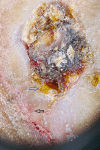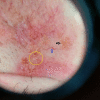Comparing Dermatoscopic Features With Slit Skin Smear and Histopathology in Diagnosis of Cutaneous Leishmaniasis
- PMID: 36974240
- PMCID: PMC10039316
- DOI: 10.7759/cureus.35336
Comparing Dermatoscopic Features With Slit Skin Smear and Histopathology in Diagnosis of Cutaneous Leishmaniasis
Abstract
Objective: To evaluate dermatoscopic features of cutaneous leishmaniasis and to compare its diagnostic accuracy against slit skin smear and skin histopathology.
Methods: This cross-sectional study was conducted at the Department of Dermatology, Pakistan Navy Station (PNS) Shifa Hospital, Karachi, Pakistan, from August 2021 to August 2022. A total of 200 lesions from 70 patients of cutaneous leishmaniasis diagnosed with slit skin smear for Leishmania-Donovan (LD) bodies and skin biopsy were included via non-probability consecutive sampling technique. Dermatoscopic evaluation was performed via a handheld dermatoscope (DELTA 20T; HEINE, Gilching, Germany) on 10x magnification. All dermatoscopic images were analyzed by two different observers who had command of dermatoscopy. Data analysis was done using Statistical Package for the Social Sciences SPSS version 27 (IBM Corp., Armonk, NY, USA).
Results: Common dermatoscopic findings were erythema 200 (100%), hyperkeratosis 140 (70%), crusting 50 (25%), ulceration 42 (21%), milia-like structure 58 (29%), tear drop-like structure 46 (23%), yellow tears 70 (35%), and white starburst pattern 68 (34%). Less common findings were yellow hue 28 (14%), orange areas 26 (13%) and scar seven (3.5%). Vascular structures frequently observed were linear vessels 109 (54.5%), dotted vessels 80 (40%), and hairpin vessels 61 (30.5%); less common findings were comma-shaped vessels 52 (26%), arborizing vessels 20 (10%), crown vessels nine (4.5%). Comparison of dermatoscopic features was done with slit skin smear for LD bodies (p value = 0.003 ) and histopathology (p value = 0.001).
Conclusions: Dermatoscopy is a non-invasive technique that is helpful in diagnosing cutaneous leishmaniasis, saving time in making rapid diagnosis and saving the need to undergo extensive invasive investigation. Yield of dermatoscopy was comparable to slit smear for LD bodies and histopathology and was found to be effective in making rapid diagnosis with significant accuracy (p value <0.05).
Keywords: cutaneous leishmaniasis; dermatoscopy; histopathology; slit smear; star-burst pattern; yellow tears.
Copyright © 2023, Memon et al.
Conflict of interest statement
The authors have declared that no competing interests exist.
Figures
Similar articles
-
Dermoscopic evaluation of cutaneous leishmaniasis.Arch Dermatol Res. 2023 Apr;315(3):531-540. doi: 10.1007/s00403-022-02387-3. Epub 2022 Sep 26. Arch Dermatol Res. 2023. PMID: 36163392
-
Dermoscopy in the Diagnosis of Cutaneous Leishmaniasis.Dermatol Pract Concept. 2019 Apr 30;9(2):111-118. doi: 10.5826/dpc.0902a06. eCollection 2019 Apr. Dermatol Pract Concept. 2019. PMID: 31106013 Free PMC article.
-
Role of In Vivo Reflectance Confocal Microscopy in the Analysis of Melanocytic Lesions.Acta Dermatovenerol Croat. 2018 Apr;26(1):64-67. Acta Dermatovenerol Croat. 2018. PMID: 29782304 Review.
-
Dermoscopic features of cutaneous leishmaniasis.Int J Dermatol. 2013 Nov;52(11):1361-6. doi: 10.1111/ijd.12114. Epub 2013 Aug 22. Int J Dermatol. 2013. PMID: 23968138
-
Dermatoscopy in inflammatory and infectious skin disorders.G Ital Dermatol Venereol. 2015 Oct;150(5):521-31. G Ital Dermatol Venereol. 2015. PMID: 26333553 Review.
References
-
- Leishmaniasis in high-burden countries: an epidemiological update based on data reported in 2014. https://www.who.int/publications/i/item/who-wer9122. Wkly Epidemiol Rec. 2016;91(22):287–296. - PubMed
-
- A nested-PCR-based schizodeme method for identifying Leishmania kinetoplast minicircle classes directly from clinical samples and its application to the study of the epidemiology of Leishmania tropica in Pakistan. Noyes HA, Reyburn H, Bailey JW, Smith D. J Clin Microbiol. 1998;36:2877–2881. - PMC - PubMed
-
- New developments in diagnosis of leishmaniasis. Singh S. https://pubmed.ncbi.nlm.nih.gov/16778313/ Indian J Med Res. 2006;123:311–330. - PubMed
LinkOut - more resources
Full Text Sources
Research Materials


